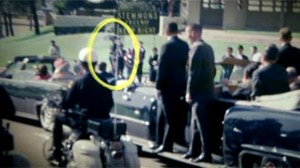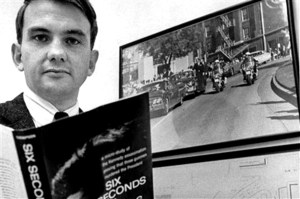Josiah Thompson was a hero of my youth. Nicknamed “Tink,” Thompson is an Oxford-educated private investigator, former Navy man, and author who wrote the ground-breaking first “micro-study of the Kennedy assassination,” Six Seconds in Dallas. Super-cool guy. He’s the kind of guy that, when you’re thinking of writing a book about the crash of TWA Flight 3, causes you say to yourself, “What would Tink Thompson do?” WWTTD? Well, of course, he’d climb the mountain, so I went and climbed the mountain.
Six Seconds in Dallas appeared in 1967, nearly 50 years ago, and now Tink is advanced in age, but he popped up in a fascinating YouTube video that had been forwarded to me, and I delighted in the concept he described—a concept developed by Pulitzer Prize-winning novelist John Updike in response to reading Thompson’s book.
In case you don’t know, when JFK was murdered in Dallas, he was riding in an open limo along a city street. At the very point where bullets rained down on him, a man stood by the curb holding an opened umbrella on a sunny Texas day. Conspiracy theorists ascribed deep meaning to that man and his umbrella: obviously he stood at the spot where triangulated gunfire from the Book Depository, the grassy knoll, and God only knows where else would have deadliest effect. Obviously, Umbrella Man was there to direct the assassination of a president.
Six Seconds in Dallas merely identified that a guy was standing there holding an umbrella and wondered why, but a decade after it was written, Umbrella Man came forward and testified before Congress about why he was there and what the opened umbrella represented: He wasn’t killing Kennedy, he was protesting the 25-year-old actions of JFK’s dad prior to the outbreak of World War II! The umbrella represented Neville Chamberlain’s appeasement of Hitler, and Joseph Kennedy’s agreement with Chamberlain’s actions.
Thompson pokes fun at himself in the YouTube video, directed by Errol Morris, and discusses a concept that Updike introduced in a New Yorker think piece about conspiracy theories and the Kennedy assassination. Basically, Thompson says that you may think you know why someone did something in the context of an important historical event, but you don’t really know.

There he is in all his weird glory, Umbrella Man, encircled in yellow along with the head of a U.S. president.
Thompson’s first book, written prior to Six Seconds, had been on the works of Kierkegaard, so Tink’s philosophical musings on the Updike theory are well grounded: “In historical research,” says Thompson of the Updike position, “there may be a dimension similar to the quantum dimension in physical reality. If you put any event under a microscope, you will find a whole dimension of completely weird, incredible things going on. It’s as if there’s the macro level of historical research, where things sort of obey natural laws and the usual things happen and unusual things don’t happen, and then there’s this other level where everything is really weird.”
Said Updike in The New Yorker in 1967, “The truth about those seconds in Dallas is especially elusive; the search for it seems to demonstrate how perilously empiricism verges on magic.” With hundreds of eyewitnesses in the area, with reporters nearby and photos being snapped and movie film being exposed, with law enforcement all over the place, there should have been one set of facts and an open-and-shut case developed about a very public murder. But then it got weird and to this day, nobody can agree who did the shooting, from where, why, who else might have been involved, or even how many shots were fired!
Seeing the YouTube video and reading Updike’s original think piece hit me like a pumpkin to the head because I had spent years trying to sort out the circumstances leading up the crash of Flight 3—circumstances that should have been sortable and explainable but read like Fiction 101. The crash of Flight 3 and the reasons why Carole Lombard died on the plane with 21 others fit perfectly with Updike’s subatomic realm because the more we apply the rules of man’s physical world, the less the story makes sense. Last weekend in Fort Wayne, for example, I spent roughly 45 minutes talking about what a wonderful person Carole Lombard was, how down to earth, empathetic, generous, and considerate. Then I was asked, “If she knew her mother was terrified to fly and the PR man had dreamt his own death on an airplane, why did Lombard force them to get on the plane?” It’s an excellent question—I complimented the woman who asked it. Then I gave her a palms-up shrug and said, “I have no idea.” In Fireball I call it the fatal flaw, Carole’s charge ahead at full speed manner of living life, and it’s the only answer I can provide. There were times when she let nothing stand in her way, including reason. Yet her actions on January 16, 1942, which shattered the emotions of her traveling companions and then shattered their bodies, don’t sound like Carole Lombard at all. They just don’t.
If it wasn’t weird enough that Carole turned a deaf ear to Petey and Wink; if it wasn’t weird enough that TWA’s most experienced pilot, the one who had trained bomber crews on how to fight a war, suddenly behaved like a rookie flyer and steered his plane right into a mountain on a clear night; if it wasn’t weird enough that Hungarian violinist Joseph Szigeti had been scheduled to fly on a DC-3 that crashed in 1940 and a DC-3 that crashed in 1942 and survived both—if all these things weren’t weird enough, I have learned of two more truly astonishing Flight 3-related incidents since Fireball went to press a year ago. Both easily qualify for the Updike Dimension, and then some.
As I mentioned to a reporter in Fort Wayne, I have now finally accessed the FBI files on the plane crash and, I kid you not, UFOs were seen in the Flight 3 airway on nights leading up to January 16. No, seriously, UFOs. Many people logically dismiss UFOs as Cold War paranoia, but we’re talking sightings of odd lights in the sky before the era of Roswell and the “flying saucer” by eyewitnesses that include a Civil Aeronautics Authority man. A fed. A trained observer equivalent to today’s FAA investigators who saw spherical lights in the sky that were not aircraft. (For the record, I don’t believe that UFOs had anything to do with the crash of TWA Flight 3. I am remarking on how bizarre it is to find UFOs in the official FBI investigation.) Then there’s the other incident that I’m still working on that’s no less odd. Neither solves the mystery of Flight 3. On the contrary, both make answers all the more elusive and demonstrate how sometimes evidence and logic go right out the window, and, suddenly, you’re in that other dimension where people are dead and nobody can figure out how they got that way.

I think the Lombard who forced others to accede to her demands in January 1942 was a vastly changed woman, the product of the enormous stresses of her marriage. Carole, an exceptionally desireable woman, had likely never been faced with such incorrigible, indiscrete unfaithfulness and she was temporarily blind to anything but the fight to keep her high profile marriage intact. Had Carole lived long enough to split from Gable, I think she would have reverted to her former generous, empathetic self. It’s too bad we never got to see that happen.
Reading back through the archives, and I just have to say how insightful and true I think this comment is from Betsy in 2014. Really moved me when I read it.
Haha. Thanks Myra!
So interesting! I’ve been told by family members that Carole Lombard is my grandmother’s aunt. I’ve walked by her old house in Fort Wayne many times! I’m so curious to learn more.
Nothing more tedious than the proud dog with bone who accepts government narratives by default and who wears that submission as a virtue. Those who parrot the words ‘conspiracy theorist’ are in fact declairing their intellectual failings, cowardice and obedience. The term ‘conspiracy theory’ was coined by the CIA to discredit those who questioned the Warren Commission’s narrative, so the chess game has come full circle and is self-contained. I’d be interested to know what Josiah Thompson’s thoughts are on the archival refractory images of a supposed rooftop sniper with rifle caught by accident on the sproket section of Zapruder’s film. It looks like a man with a rifle and flashes correspond with one of the head shots, but this could also be fluff and bits of dirt.